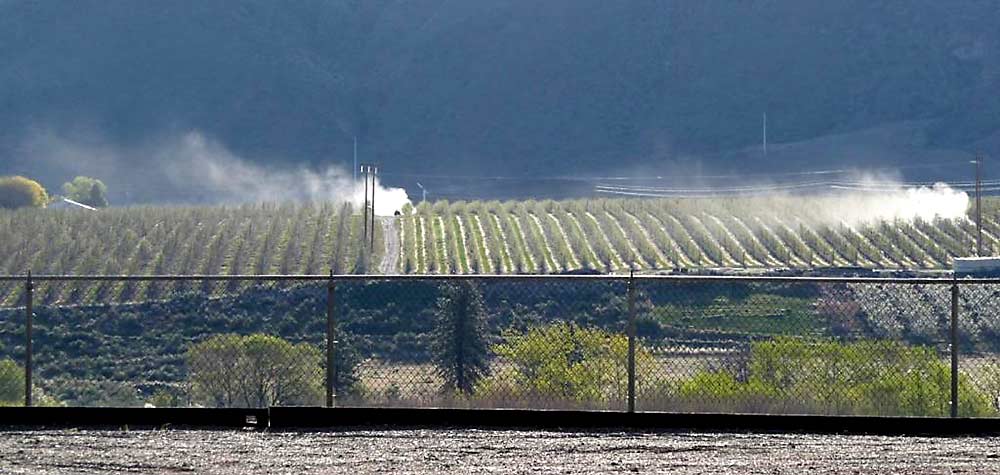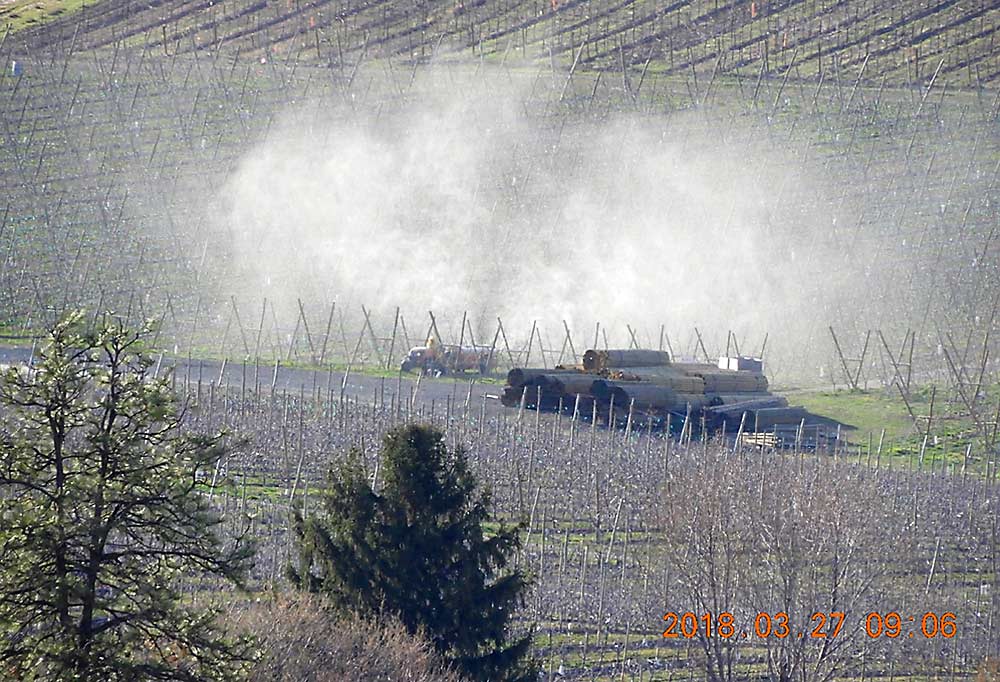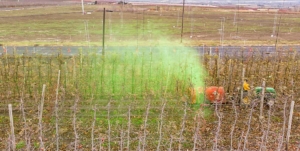
When you start up your airblast sprayers this spring, the Washington State Department of Agriculture will be watching.
It’s part of a new enforcement effort referred to as the Drift Observation Project, said Tim Schultz, compliance program manager for the WSDA’s pesticide division. The agency launched it at the behest of ag industry groups, including the Washington State Tree Fruit Association, the Washington Farm Bureau, Washington Friends of Farms and Forests and others who, in February 2020, urged the WSDA to use its existing authority to put more effort into airblast drift education and compliance, in hopes of warding off additional regulations.
“If we are driving down the road and see drift occurring, when it’s leaving the target area, we will take a photo and then we’ll make contact with the grower and applicator to let them know what we just observed,” Schultz said.
Rather than launch a full inspection — the WSDA’s standard pesticide inspection includes evaluating pesticide labels, equipment, PPE, weather, chemical storage, record keeping and more — the project created a shorter-format inspection focused on drift. That means questions will focus on product label requirements for drift, how the sprayer plume contributed to drift, weather conditions and where the drift was going, Schultz said. Pesticide application records will be used to verify information.
“It’s a good way to have our staff out more and address drift in a shorter time frame,” Schultz said.
The tree fruit industry supports the new emphasis on both education and enforcement, said Jon DeVaney, president of the Washington State Tree Fruit Association.
“If there’s a drift event, the first thing people say is, ‘The rules are inadequate,’” DeVaney said. “But the first question should be, ‘Were the rules followed?’” Most growers follow pesticide labels to the letter, he said, but it’s in the industry’s best interest for the WSDA to find anyone who isn’t. “If they didn’t know what they should have been doing, offer them technical support, and if they did know and just didn’t do it, there’s compliance for that.”
In the 2020 fiscal year, the WSDA investigated 61 cases of pesticide drift, with 24 of those from airblast sprayers.
The drift-focused compliance project relies on WSDA’s existing resources, but the agency is asking state lawmakers to approve a fee increase on pesticide registrations and applicator licenses to fund a pesticide safety reform package. The package aims to increase technical assistance and training resources to help farmers reduce drift.

Kelly McLain, policy advisor to the WSDA director, said the proposal was developed in conversation with ag industry groups to see how the agency could use its existing authority to reduce drift and human exposure to pesticides. While no one likes fee increases, “we hope it looks like a good investment to help farmers stay safer and reduce liability,” she said. “Everyone wants to see drift reduction. This puts us in a place to talk about the work the agency and the industry is already doing.”
Sprayer calibration is complicated and specific, so WSDA devised a program to send trainers to farms to work with spray supervisors on how to properly calibrate and optimize their own equipment and how to observe and respond to weather conditions, said Ofelio Borges, WSDA’s program manager for technical services and education in the pesticide management division.
“We come to your place and give you advice that’s applicable to your equipment and your specific site,” he said. “It’s important for the grower community to know that we are not here to police them; we are here to help them.”
Properly calibrating equipment saves growers money, increases product effectiveness and protects people and the environment, Borges added.
The proposal would raise pesticide registration fees from $195 a year to $260 a year, a move which would still keep Washington far below states such as California ($1,150) and New York ($620), McLain said, providing $900,000 of the $1.1 million needed for the new program. Pesticide licensing fees would go up 15 to 30 percent ($5 to $30, depending on license type), plus a $7 fee to support Washington State University’s Pesticide Safety Education Program.
That funding would support three additional positions each in both technical support and compliance as well as additional staffing for pesticide registration and would also fund modernization of the registration and licensing databases, she said.
While fee increases are a tough sell, it’s the first increase for the program since 2008, DeVaney said, and funds efforts the tree fruit industry wants. The Washington Winegrowers Association assistant director Sara Higgins said that while fee increases raised some concerns, it supports the program’s goals to support education and implementation of best management practices to prevent exposure incidents.
While his program’s focus is compliance, Schultz said he hopes the drift focus will encourage more growers to be proactive about trainings and technical resources available to prevent drift in the first place.
“We’re hoping that with our being out and about a bit more, growers will be more aware of their operations and their employees running the sprayers will be more aware of their surroundings so that the end result will be more people paying more attention to their sprayers, more attention to the weather, and so, if someone sets up a picnic next to the orchard, they can stop and assess the situation,” Schultz said. “The end goal for the farmer is helping them to be in compliance so we just drive by and wave if we see them out spraying.” •
—by Kate Prengaman







Leave A Comment